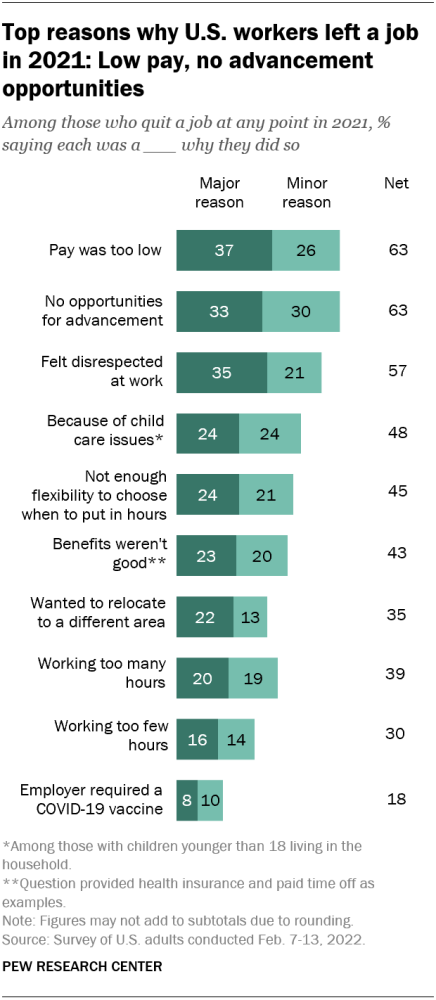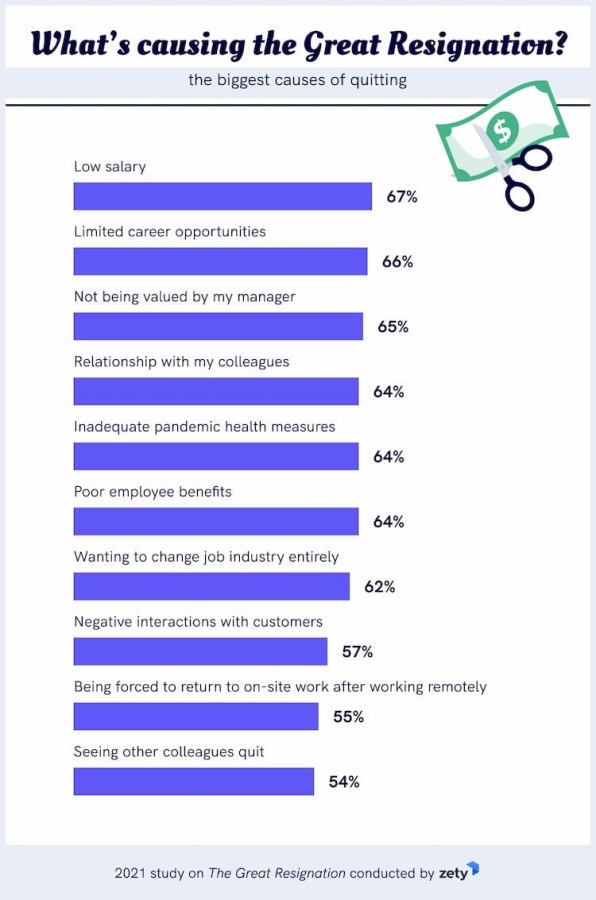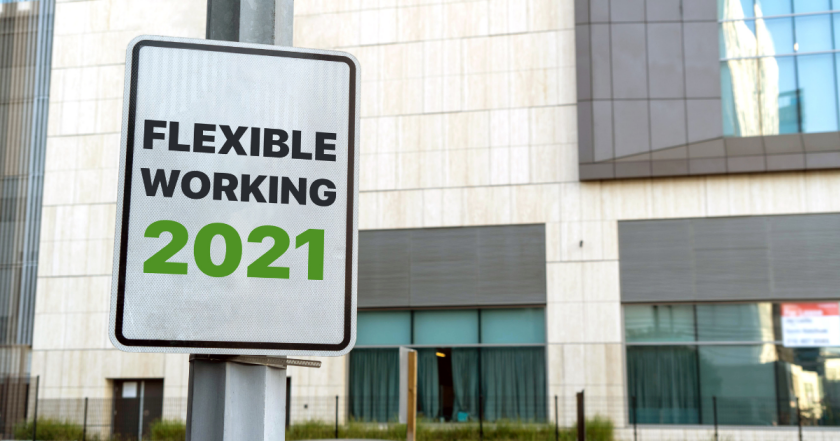How To Deal with The Great Resignation And Succeed At Talent Retention & Acquisition
DISCLAIMER
Copyright ©2022 by DivIHN Integration Inc. | [email protected].
The creator of the document reserves all rights. Publication Date: June 2022. DivIHN Integration Inc. reserves the right to change the contents of this article, the features or the scope without the obligation to notify anyone of such changes. The content has been adapted using secondary research from various data points via “Google Search”. Infographics and Images used in the document are the property of the respective owners and have been used for indicative purposes only. The author reserves the right to authorize and use the Intellectual Property contained in the document.
Table of Contents
|
Executive Summary
It is very likely that being an American Corporate Professional, you must be well aware of “The Great Resignation”. It is also known as the “Big Quit” and the “Great Reshuffle”. This refers to the mass exodus of American workers from their current jobs in layman’s terms. Corporate America and its citizens had to bear the aftermath of COVID-19 resulted in two years of unemployment uncertainty, long hours of remote work, layoffs and ambiguity about the future. The employees decided to move on.
Anthony Klotz, a management professor, is credited with coining the phrase. Despite the widespread belief that the Covid-19 pandemic was the catalyst for this trend of workers voluntarily quitting their jobs, the pandemic may have expedited an existing, if not overwhelmingly pervasive, problem. In the opinion of Fuller and Kerr (2022), the great resignation began well before the pandemic, as employees started to leave in more significant numbers at least ten years before the outbreak of Covid.
According to a study done by Pew Research Center, the primary reasons for this unprecedented phenomenon are low pay, lack of opportunities for professional growth and improper recognition in the workplace. The infographic below will help to understand it better.

Another research done by Zety closely echoes the findings in the Pew Research Centre report with some additions to the list, as evident from the infographic below.

What is driving “The Great Resignation”
Let’s investigate the factors that ignited such a disruptive mass movement in the upcoming sections.

Low Wages
Low-wage workers were hit much harder by the pandemic-induced loss of jobs than higher-wage workers were, and even though hiring has increased in low-wage industries over the past month, low-wage jobs have been the slowest to return. We can never undermine the impact that losing a job can have on workers of all levels; in fact, the victims of the pandemic-induced recession include workers with middle and higher incomes.
Even though there may be a record number of job openings, this does not necessarily mean that companies are paying wages that workers are willing to accept.
Per the Bureau of Labor Statistics, the hourly wage for all jobs in the private sector has increased by more than $1 in the past year, an increase of 4.5%. For example, the median hourly wage in the leisure and hospitality industry has increased by 11%, reaching $18.95 in recent years. This upward trend is attributed to the pressure on earnings and increased worker demand.
According to Aaron Sojourner, a labour economist and associate professor at the University of Minnesota, the higher pay might not be enough to entice workers sitting on the sidelines. According to him, higher wages are announced more likely when the quality of a job has decreased. Some reasons could be increased hours, increased health risks, or other inconveniences such as dealing with unruly customers who object to wearing masks to work regulations. There could also be a competing priority, such as the expense of finding suitable child care.
Toxic Corporate Culture
According to research done by MIT, Toxic corporate culture is one of the significant drivers of employee turnover we better know as “The Great Resignation”. According to the findings of the research, the most important factors that contribute to toxic cultures are the following:
- The failure to promote diversity, equity, and inclusion
- The perception among workers of being disrespected
- Unethical behavior.
According to another survey, employees who do not feel appreciated are more likely to quit their jobs. Millennials are more prone to jumping the gun than other coworkers to seek new employment if their peers or superiors do not give them attention, recognition, and respect. Eight out of every ten individuals are looking for a new job.

Employers that failed to differentiate between their performers and laggards had to bear the brunt of good employees leaving them. Money wasn’t the sole criteria for those who decided to move on.
High-performing employees are the most likely to be dissatisfied with their employers’ failure to recognise their accomplishments, leading to the companies losing some of their most productive employees during the Great Resignation.
In another article, there is a deeper dive into each factor. The researchers examine different ways managers and employees can spot signals of a toxic culture in their respective organisations. The key takeaway from the above conversation is that a toxic culture is a critical reason so many employees left their jobs during the Great Resignation.

Insecurity and Uncertainty
It should not be surprising that job insecurity and restructuring contribute to employee turnover rates. Managers frequently resort to layoffs and reorganization when the business outlook isn’t encouraging. Employees’ negative assessments of their company’s prospects strongly predict attrition.
When a company is experiencing financial difficulties, employees are more likely to leave in search of greater job security and professional advancement opportunities elsewhere. Furthermore, post layoffs have typically resulted in increased workloads for existing employees, which may increase their likelihood of quitting the company.
In addition, employee attrition, which incorporates job changes for all reasons — including layoffs and involuntary terminations — could predict turnover if job insecurity exists. Explicit mentions of reorganisations and layoffs would lead us to believe there would be a high rate of involuntary departures.
Based on the data from research findings by the United States Bureau of Labor Statistics during the Great Resignation, involuntary terminations accounted for a percentage of employees leaving large corporations that were less than one-quarter of the total.
Break Neck Competition For Remote Jobs
Remote work has many advantages for employees. They realized the positives of working from home only a few months into the pandemic. One out of every two workers does not want to return to their previous jobs because they do not allow remote working. Therefore, employers must accept remote work as the norm rather than a perk available to all employees.
The cultural change at many organizations posts the pandemic that encouraged remote working has proven to be a shot in the arm. It is one of the most inclusive things that has happened to us in recent history. On the other hand, obtaining this benefit proved to be extremely difficult.

Employers were required to offer remote work to remain competitive, but only a few companies took the initiative. After the severity of the pandemic decreased, many employees expressed a desire to return to their jobs. Because of this, there was a bottleneck in the process.
A survey conducted by Ernst & Young found that employees continue to demand flexibility from their jobs and that 54% of employees are considering leaving their job if they are not allowed the freedom to accomplish the tasks allocated to them in their roles the way they wish to. Businesses need to ensure that their workforce is happy in 2022. The current working models must be adapted to support hybrid or fully remote work.
The data shared above establishes the paradigm shift toward working from home especially post the pandemic. This has proven to be another crucial driver leading to “The Great Resignation”.

Child Care Issues
It is a pandemic-induced issue. According to Wall Street Journal, a shortage of childcare workers has left nearly 500,000 families without access to childcare. This development has caused many parents to remain at home, negatively impacting the labor market.
Using data on the labor market, economists from Wells Fargo determined that the decline in daycare employment from levels seen before the pandemic has resulted in approximately 460,000 families still requiring alternative arrangements.
The more recent data substantiates that a lack of childcare workers is creating a ripple effect throughout the workforce in the United States, creating obstacles for businesses attempting to hire more workers. The snowball effect is making a sizeable impact on the professional lives of women.
According to research conducted by Wells Fargo, the task of caring for children at home increasingly falls on the shoulders of the mother as working parents struggle to find appropriate childcare. As per the data provided by the government, the percentage of women actively participating in the workforce is currently in its worst phase in decades due to the pandemic.
It is clear that the pandemic created a “Snowball Effect.” Resulting in the mass exodus of the workforce.
Overworked Staff
The pandemic made many people’s jobs more difficult and highlighted the ongoing challenges faced by employees in various sectors and industries. The continuing public health emergency and its subsequent impact on healthcare workers enlightened the industry with long-ignored areas of concern: Lengthy Work Schedules, Inappropriate pay for healthcare workers like nurses, and The dangerous but essential nature of their work.
Frontline workers in restaurants and grocery stores found their wages frequently insufficient to maintain a decent standard of living. However, they were applauded for their bravery but were forgotten very soon.

And workers who toiled in e-commerce warehouses or offered delivery services became integral cogs in the US economy harshly, as their complaints about inhumane workplace treatment went uncorrected.
Even white-collar workers, who are better compensated and have better job security than many blue-collar workers, are experiencing high rates of burnout and mental health issues. The aftereffect has prompted them to question the meaning of their work in their lives and whether it was ever necessary for them to commute daily from their homes to work on computers elsewhere. On the other hand, blue-collared employees are more likely to be injured on the job and face a greater risk of death.
Such work environments led to a rise in the number of people quitting their jobs. To make up for the loss of their colleagues, many employees had to overcompensate. It has always been true that understaffing and the desire for a talent war exist, but the effect of these factors was significantly different during the Great Resignation.
Businesses with limited resources commonly use the “do more with less” staffing model. Nevertheless, this approach proved ineffective when faced with the uncertainties that a pandemic can bring about.
These workers’ wages were raised, and their health insurance was improved, thanks to the efforts of employers and human resource managers. On the other hand, employee burnout was exacerbated by understaffing and overwork.

Flexible Working
According to the Future Forum, a consortium led by Slack Technologies, the New Normal or the Hybrid working model has been inspired by the pandemic.
Employers reluctant to offer flexible work arrangements had to bear the brunt of disgruntled employees moving on to other organizations, quitting altogether, or joining a completely different industry.
The vast majority of people in the global knowledge economy now control the hours and locations they put in their work. 78% of those who took the survey expressed a desire for location flexibility, an increase from the previous quarter’s percentage of 76%.
95% desired schedule flexibility (up from 93% ). Executives concerned about the Great Resignation should note that requests for more flexibility are not “empty threats” among their employees. 72% of workers who are dissatisfied with their current level of flexibility at work say that they will look for more meaningful job opportunities in the next year, compared with 58% of all respondents. This finding is significantly higher than the percentage of workers who said they were likely to look for a new job in the previous year.
The desire for flexibility is powerful among people of colour, women, and working mothers, all of whom have historically been underrepresented in knowledge work.
In comparison, only 75% of white knowledge workers prefer a hybrid or remote work arrangement. At the same time, 86% of Hispanic and Latin knowledge workers, 81% of Asian and Asian American knowledge workers, and 86% of black knowledge workers would choose such an arrangement if given a choice.
How To Circumvent Such A Disruption?
Focus on Employee Mental Health and Well-Being
The Covid-19 pandemic wreaked havoc worldwide and had a particularly devastating impact on the human race. Since the stress on employees resulting from such events cannot be separated from the workplace, Businesses should focus on whole-person wellness. Such an approach will create a win-win situation for all the stakeholders.
A company’s ability to prioritise primary care access for employees who might not otherwise have access can build long-term employee trust and loyalty. Medical assistance can be arranged on an as-needed basis, with direct access to doctors and phone consultations, reducing the physical and mental strain on company employees.
Employment counseling, promoting the use of medical leave, and increasing human resource resources to handle increased volume are all actions that go above and beyond what employees expect from their typical employer. Their retention efforts are not limited to a particular geographical area.
No single approach is appropriate for all situations. In all of this, one thing remains constant: empathy is an essential quality in leadership. Consider that the bolder and more meaningful the initiatives you put into place, the greater the likelihood that your employees will notice them.
Execute Empathy
According to its proponents, employees who want more flexibility also drive the Great Resignation. It is not enough to tell your employees what they can and cannot do; The HR policies must be renovated, and senior leadership must model those behaviors. While it is possible to tell people that they can take an extended lunch break or a day off for their mental health, words alone do not always compel employees to act.
Acting in the desired manner by others is what leaders should do instead. It might be worthwhile to institute times when people are discouraged from scheduling meetings, such as Friday afternoons.
Employees can use their time however they wish, with no restrictions. To set aside time on their calendars for errands or family time as needed, leaders must set an example by setting aside time for themselves. One day a month, set aside for your employees to recharge their batteries so that they don’t have to use their vacation time or deal with the stress of an overflowing inbox when they return to the office.
The HR executioners should conduct surveys to gather feedback and learn how employees’ needs change to stay in touch with them. Someone affected by Covid-19 may find a 90-day sick leave policy extremely beneficial; this is especially true if they must care for family members. In the case of working from home, a weekly food delivery voucher could alleviate the burden of cooking or eating out every week.
The solutions to these issues will likely be as diverse as the backgrounds and situations of your employees. These benefits aid in employee retention, but they could also develop a positive company culture that encourages greater employee participation and participation.
Encourage Lateral Movement
Companies must provide opportunities for lateral job moves within their organizations because burnout is one of the primary causes of the Great Resignation. MIT researchers discovered that people suffer from burnout because they do not have enough new challenges or opportunities to try something different.
According to research, employees offered new positions at their companies are almost 12% less likely to resign from their current positions. It is not only possible to increase employee motivation by climbing the vertical ladder, but it is also a good idea. Workers can learn new skills by moving to the side or the back of the room. In addition, it boosts their self-esteem.
Additionally, international postings are a significant incentive because they allow gaining new knowledge and experience.
Inculcate A Sense of Purpose
Employees have come to terms with the new normal. Their lives were characterized by sickness and isolation, work-related stress and burnout, inadequacy, disengagement, and other feelings. According to many studies, the factors listed above played a role in the Great Resignation. As previously stated, total pay packages are not the only solution to the problem.
Providing meaning and instilling a sense of purpose in employees’ lives is the only way for employers to address qualitative problems such as burnout and disengagement.
Businesses must assist employees in connecting their company’s mission and values to their objectives to retain top talent in their organizations. To keep your employees, you’ll need to persuade them that the benefits of coming to work each day outweigh the stress, lost time, and missed opportunities they will experience due to their participation.
Develop A Culture Of Positive Recognition
In a nutshell, recognizing and rewarding your performing employees is one of the most valuable assets you can give them.
Another key learning from the Great Resignation is that public recognition should be diverse and varied. Managers must prioritize employee engagement and other factors to retain employees.
Salaries and monetary benefits, of course, can help to increase employee morale. However, they are only effective as brakes for a short period, preventing employee churn temporarily. A business can reap long-term benefits from investing in systems and processes that focus more attention on each employee.
Frequent check-ins are one of the most effective strategies. A structured plan for these check-ins is not required. Check-ins lasting 3-5 minutes that allow employees to discuss goals, priorities, and roadblocks have significantly boosted employee focus, morale, and productivity.
Succession Planning
Employee retention can sometimes feel like a losing battle, especially in uncertain economic times. Employees will decide where and with whom to work because many job opportunities are available with other employers. It does not matter how hard employers try to incentivize job roles. It pays to plan ahead of time in such situations.
You can keep workflows running optimally If you plan for succession. In the case of top-tier talent, this strategy is highly effective. Keep the knowledge of employees who wish to leave to avoid workflow disruptions that would be show-stopping.
Mentoring and Training Managers
Management tried everything to keep their employees happy, but the pandemic-induced lockdown and subsequent transition to remote work were extremely difficult for them. Employee sentiment due to this disruption was not positive.
Based on the findings in a study done by Society for Human Resource Management study, 84% of professionals in the United States attributed unnecessary stress created by ill-trained managers.
Managing the remote workforce is an uphill task in terms of the time and resources of people managers. Training your managers is an essential step. Your managers deserve more training, motivation, and recognition to equip themselves better to reduce employee turnover rates in their organizations.
Concluding Remarks
According to Peter Schlampp, Chief Strategy Officer, Workday
“The number one thing that the C-suite will continue to think about in 2022 is talent. We will go from The Great Resignation into a world of the rising voice of the employee. They’re making decisions about where they want [to work]. They want more flexibility in their job. They want to work for companies with a mission and a purpose they believe in. They want to be heard. And if talent is the top thing on [executives’] minds, it will be incumbent on them to listen and put in place the processes to listen to their employees.”
Employers must empathize with the needs of their staff, accommodate their work preferences, and address inequities for employee retention. They will have to provide competitive benefits and pay.
DivIHN Workforce Solutions
DivIHN Integration Inc. offers alternative talent solutions to help organizations reimagine their talent strategy. Our expertise includes
- Enterprise contingent staffing
- MSP-Channel Staffing
- Direct-Hire Staffing
- Flexible Staffing
- TalentGen
- Staffing Advisory
To know more, please write to [email protected].



